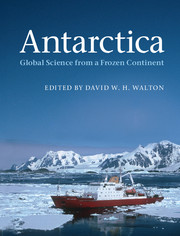Book contents
- Frontmatter
- Contents
- List of contributors
- Introduction
- 1 Discovering the unknown continent
- 2 A keystone in a changing world
- 3 Ice with everything
- 4 Climate of extremes
- 5 Stormy and icy seas
- 6 Life in a cold environment
- 7 Space science research from Antarctica
- 8 Living and working in the cold
- 9 Scientists together in the cold
- 10 Managing the frozen commons
- 11 Antarctica: a global change perspective
- Appendix A Visiting Antarctica
- Appendix B Further reading
- Acknowledgements
- Index
7 - Space science research from Antarctica
Published online by Cambridge University Press: 05 March 2013
- Frontmatter
- Contents
- List of contributors
- Introduction
- 1 Discovering the unknown continent
- 2 A keystone in a changing world
- 3 Ice with everything
- 4 Climate of extremes
- 5 Stormy and icy seas
- 6 Life in a cold environment
- 7 Space science research from Antarctica
- 8 Living and working in the cold
- 9 Scientists together in the cold
- 10 Managing the frozen commons
- 11 Antarctica: a global change perspective
- Appendix A Visiting Antarctica
- Appendix B Further reading
- Acknowledgements
- Index
Summary
The eastern sky was massed with swaying auroral light, the most vivid and beautiful display I have ever seen – fold on fold the arches and curtains of vibrating luminosity rose and spread across the sky, to slowly fade and yet again spring to glowing life.
R. F. Scott, 22 June 1911Introduction
At the ends of the Earth it is not only the land and the seas that are unusual. Even the upper atmosphere is different, providing remarkable insights into the way in which the planet interacts with the Sun and evidence for our wandering magnetic fields. The most striking visible evidence of these phenomena are the lights in the winter sky – the Aurora Australis – produced by the interaction of solar emissions with Earth's environment, and first seen by European explorers in 1773 by Captain James Cook's expedition. Of course, this southern equivalent of the ‘northern lights’ was observed on occasion by native peoples of the southern regions of New Zealand and Australia. To the Maoris, the aurora was known as Tahu-Nui-A-Rangi, a red glowing of the sky resulting from reflections of great fires. Similarly, the aboriginal people in Australia viewed the aurora as the feast fires of the Oola-pikka, ghostly spirits who spoke to the elders through these auroral flames. Modern explanations, albeit less fanciful, are certainly just as colourful, and centre on complex electromagnetic interactions between the Sun and Earth.
- Type
- Chapter
- Information
- AntarcticaGlobal Science from a Frozen Continent, pp. 211 - 228Publisher: Cambridge University PressPrint publication year: 2013



